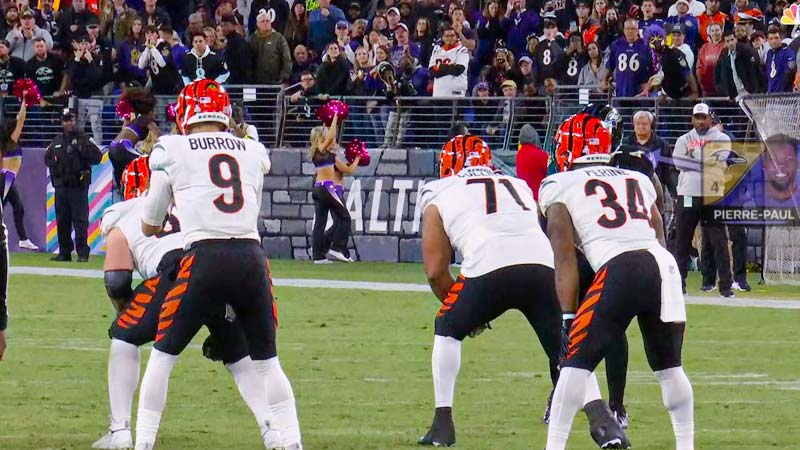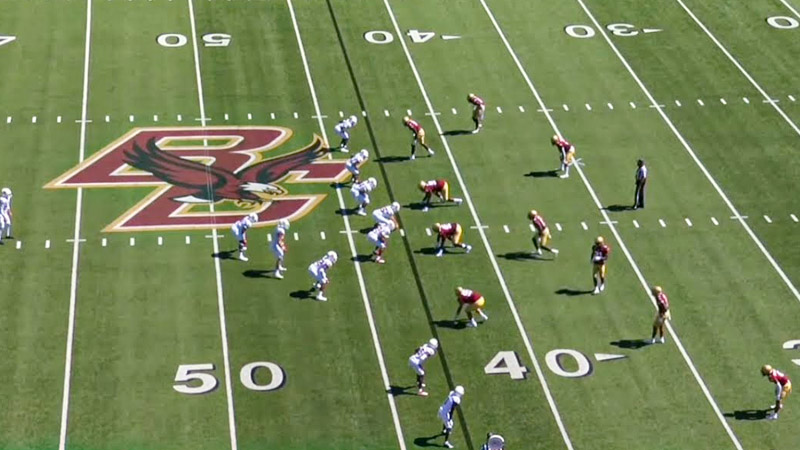In the world of American football, few moments rival the intensity and strategic complexity of the “4th and Goal” situation. This juncture in a game combines raw athleticism, calculated decision-making, and the thrill of high-stakes competition.
Whether you’re a seasoned fan or a newcomer to the sport, understanding the significance of “4th and Goal” play is crucial for grasping the heart and soul of football.
In this blog post, we’ll dive deep into the world of “4th and Goal,” exploring frequently asked questions and shedding light on the drama and strategy that make these moments the stuff of sports legends. Stay focused.
What Is Football 4th And Goal?
“4th and Goal” is a critical juncture in American football, signaling that a team is on its fourth down and the distance to the end zone is less than ten yards.
This situation occurs within the opponent’s territory, placing immense pressure on the offensive team to either score a touchdown or attempt a field goal.
The team must strategically decide whether to execute a play that could lead to a touchdown, earning them six points, or opt for a field goal, worth three points. The decision balances the potential reward of a touchdown against the safer choice of securing a field goal.
4th and Goal moments often exemplify the intensity of the game and the strategic thinking that underpins football, where teams must swiftly decide between high-risk and high-reward options to advance their score.
Strategic Approach of Football 4th And Goal

In a “4th and Goal” situation in American football, teams face a pivotal strategic choice that can significantly impact the outcome of the game. Coaches and players must consider several factors when deciding on their approach:
Field Position
The location of the field influences the decision. If the team is closer to the end zone, attempting a touchdown might be more appealing. If farther away, a field goal attempt could be the wiser choice.
Score Differential
The current score plays a role. If a team is trailing by a significant margin, they might opt for a higher-risk play to close the gap. If ahead, a conservative choice could prioritize maintaining the lead.
Time Remaining
The game clock matters. Late in the game, urgency might lead teams to pursue higher-risk plays to quickly score points.
Opponent’s Strength
The opponent’s defensive strengths and weaknesses inform the play call. Exploiting vulnerabilities or capitalizing on prior successes can influence the decision.
Offensive Momentum
If the team’s offense has been performing well, coaches might opt for a more aggressive play call to maintain momentum.
Kicking Accuracy
When attempting a field goal, the kicker’s accuracy and distance capability are crucial considerations.
Field Conditions
Weather and field conditions can impact the success of a play or a kick. It is really a matter of concern.
Timeouts
The number of remaining timeouts affects the decision-making process, allowing teams to assess options more thoroughly.
Team Philosophy
Some teams have a reputation for being aggressive risk-takers, while others lean towards conservative strategies. The team’s overall philosophy can guide the decision.
In essence, the strategic approach involves a delicate balance between risk and reward.
The Aftermath of 4th And Goal in American Football

The aftermath of a “4th and Goal” situation in American football can significantly influence the momentum and outcome of the game:
Conversion Success
If the offensive team successfully converts on 4th down and scores a touchdown, it can lead to a surge in morale and energy. The team gains valuable points and maintains possession, potentially shifting the game’s momentum in their favor.
Touchdown Celebration
Scoring a touchdown on 4th and Goal often results in enthusiastic celebrations among players, fans, and coaches. The emotional boost can inspire the team and create a more charged atmosphere.
Defensive Stand
If the defensive team successfully prevents the offensive team from converting on 4th down, it gains possession at an advantageous field position. This can demoralize the opposing team and energize the defensive players and fans.
Field Goal Attempt
Opting for a field goal attempt can result in scoring three points, even if a touchdown isn’t achieved. This choice can narrow the point gap between teams and impact the overall strategy for the remainder of the game.
Turnover on Downs
Failing to convert on 4th down without attempting a field goal hands possession over to the opposing team with an advantageous field position. This can lead to a shift in momentum and provide the opposing team with a scoring opportunity.
Momentum Shift
The outcome of a “4th and Goal” play can alter the psychological and emotional dynamics of the game. A successful conversion can boost a team’s confidence and momentum, while a failure can deflate morale.
Strategic Adjustments
The aftermath prompts both teams to make strategic adjustments based on the new game situation. Coaches may revise their offensive and defensive plans to account for changes in field position and score differentials.
Fan Engagement
The outcome of a critical 4th and Goal play can evoke strong reactions from fans, enhancing the game’s excitement and engagement.
Game Flow
Depending on the outcome, the game’s pace and rhythm can change. Successful conversions might lead to more aggressive play-calling, while defensive stands could result in a more cautious approach.
Significance of Football 4th And Goal

The significance of a “4th and Goal” situation in American football is multi-faceted and underscores the strategic complexity and excitement of the game:
Decisive Moments
“4th and Goal” represents a critical juncture where a team’s strategic decisions can have a profound impact on the game’s outcome. The pressure to convert and score intensifies, making these moments crucial turning points.
Risk and Reward
The decision to go for a touchdown or attempt a field goal involves a delicate balance between risking it all for a higher reward (touchdown) and choosing a safer, albeit lesser, reward (field goal). This encapsulates the essence of strategic decision-making in sports.
Strategic Thinking
Coaches and players must rapidly assess various factors such as field position, time remaining, and the opponent’s strengths to make informed choices. This showcases the team’s strategic acumen and adaptability.
Team Cohesion
Successfully converting on 4th and Goal often requires coordinated teamwork, precision execution, and trust among players. It exemplifies a team’s ability to come together under pressure.
Game Narrative
The outcome of a “4th and Goal” play can shape the narrative of the game, creating memorable moments that fans and analysts discuss long after the game ends.
Showcases Coaching
Coaches’ decisions on whether to go for it, kick a field goal, or punt reveals their strategic thinking, confidence in their team, and willingness to take calculated risks.
Spectacle and Drama
The tension and drama of a “4th and Goal” play add excitement to the game, captivating both casual fans and dedicated followers.
Defining Games
In close matchups, pivotal 4th and Goal plays can become defining moments that define a team’s resilience, determination, and ability to thrive under pressure.
Strategy vs. Intuition
Teams must balance analytical strategy with instinct and gut feelings. This dynamic showcases the blend of careful planning and spontaneous decision-making inherent to football.
High-Stakes Nature of Football 4th and Goal

The high-stakes nature of “4th and Goal” in American football is a defining aspect of the sport, encapsulating tension, strategy, and excitement:
Critical Moment
“4th and Goal” marks a pivotal point in the game where the outcome of a single play can dramatically impact a team’s chances of scoring and winning. The pressure is magnified due to the limited opportunities remaining.
Game-Changing Potential
The decision made on 4th down can lead to game-changing results. Successfully converting can shift momentum, alter score differentials, and create opportunities for a comeback or a decisive lead.
Strategic Dilemma
Coaches face a strategic dilemma that requires weighing the potential reward of a touchdown against the risk of turning over the ball. This tension encapsulates the essence of strategic decision-making in sports.
Team Unity
The high stakes demand close teamwork and synchronization. Players must execute plays flawlessly under immense pressure, highlighting their cohesion and trust in one another.
Fan Engagement
“4th and Goal” moments captivate fans, generating heightened emotions and investment in the game’s outcome. The thrill of these high-pressure scenarios enhances the overall fan experience.
Legacy Building
Successful plays on 4th down can define players’ legacies. Players who rise to the occasion during critical moments become celebrated for their clutch performances.
Defining Moments
“4th and Goal” play can shape the narrative of individual games and even entire seasons, serving as defining moments that showcase a team’s resilience, character, and ability to perform under pressure.
Game Strategy
The high-stakes nature of “4th and Goal” often prompts teams to employ unique and innovative plays, demonstrating their adaptability and willingness to think outside the box.
FAQs
What is “4th and Goal” in football?
“4th and Goal” refers to a critical game situation where a team is on its fourth down and the distance between the line of scrimmage and the end zone is less than ten yards. It signifies the team’s last chance to either score a touchdown or attempt a field goal before surrendering possession to the opposing team.
Why is the “4th and Goal” situation significant?
The significance lies in the high-stakes nature of the situation. Teams must make strategic decisions that can greatly influence the game’s outcome. The choice between going for a touchdown, attempting a field goal, or punting represents a delicate balance between risk and reward.
What factors influence the decision-making on 4th and Goal?
Several factors come into play, including field position, the score differential, time remaining, opponent’s strength, offensive momentum, kicking accuracy, field conditions, and the team’s overall philosophy. Coaches and players must assess these elements swiftly to make informed choices.
What are the potential outcomes of a “4th and Goal” play?
A successful conversion could lead to a touchdown, earning the team six points and retaining possession. Alternatively, teams may attempt a field goal to secure three points. Failing to convert might result in turning the ball over to the opponent with an advantageous field position.
How do “4th and Goal” plays impact the game’s momentum?
The outcome of a “4th and Goal” play can trigger momentum shifts. Successful conversions can energize the team, and fans, and even impact the opponent’s morale. Conversely, defensive stops can deflate the offense and invigorate the defense, altering the overall course of the game.
Wrapping Up
In the realm of American football, “4th and Goal” plays are the epitome of strategic decision-making under pressure. These moments encapsulate the essence of the sport, combining athleticism, strategy, and the thrill of competition.
As we’ve explored the intricacies of “4th and Goal” situations and answered some common questions, it becomes clear that these moments are not just about scoring points – they’re about defining the narrative of a game that resonates with players and fans alike. Thank you for your support.







